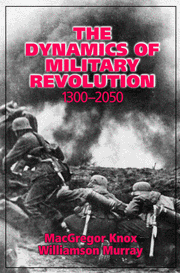Book contents
- Frontmatter
- Epigraph
- Contents
- Contributors
- Acknowledgments
- List of figures and tables
- 1 Thinking about revolutions in warfare
- 2 “As if a new sun had arisen”: England's fourteenth-century RMA
- 3 Forging the Western army in seventeenth-century France
- 4 Mass politics and nationalism as military revolution: The French Revolution and after
- 5 Surviving military revolution: The U.S. Civil War
- 6 The Prusso-German RMA, 1840–1871
- 7 The battlefleet revolution, 1885–1914
- 8 The First World War and the birth of modern warfare
- 9 May 1940: Contingency and fragility of the German RMA
- 10 Conclusion: The future behind us
- Index
9 - May 1940: Contingency and fragility of the German RMA
Published online by Cambridge University Press: 05 February 2015
- Frontmatter
- Epigraph
- Contents
- Contributors
- Acknowledgments
- List of figures and tables
- 1 Thinking about revolutions in warfare
- 2 “As if a new sun had arisen”: England's fourteenth-century RMA
- 3 Forging the Western army in seventeenth-century France
- 4 Mass politics and nationalism as military revolution: The French Revolution and after
- 5 Surviving military revolution: The U.S. Civil War
- 6 The Prusso-German RMA, 1840–1871
- 7 The battlefleet revolution, 1885–1914
- 8 The First World War and the birth of modern warfare
- 9 May 1940: Contingency and fragility of the German RMA
- 10 Conclusion: The future behind us
- Index
Summary
The Second World War resumed, after twenty years' unquiet truce, the military revolution of 1914–18. The greatest war in history was not a mere sequel: it was the continuation after brief respite and under new management of the bid for world mastery that Imperial Germany had launched in 1914. It was the culmination of the Great War's fusing of French and Industrial Revolutions into an unholy trinity of mass fanaticism, science and technology, and the matchless organizational and productive–destructive capacities of the industrial state.
But despite the clarity with which the modern style of warfare described in the preceding chapter emerges in retrospect, the tactical, operational, and technological meaning of the Great War was far from clear to those who surveyed the wreckage after 1918. The unparalleled profusion of RMAs that sprang up in the interwar period on the basis of the insights acquired and technologies introduced in 1914–18 gestated amid ambiguities both multiple and profound. Those who contributed to the development of new techniques remained uncertain of their potential until the grim audit of war in 1939–45. The adaptation of combined-arms tactics and operations to the pace of the internal combustion engine by Reichswehr and Wehrmacht offers perhaps the most striking example of the extent of those uncertainties and ambiguities.
By late May 1940 the results of the combined-arms armored warfare RMA appeared clear at last in the devastating victory of the German armies over the Allied forces in northern France.
- Type
- Chapter
- Information
- The Dynamics of Military Revolution, 1300–2050 , pp. 154 - 174Publisher: Cambridge University PressPrint publication year: 2001
- 4
- Cited by



